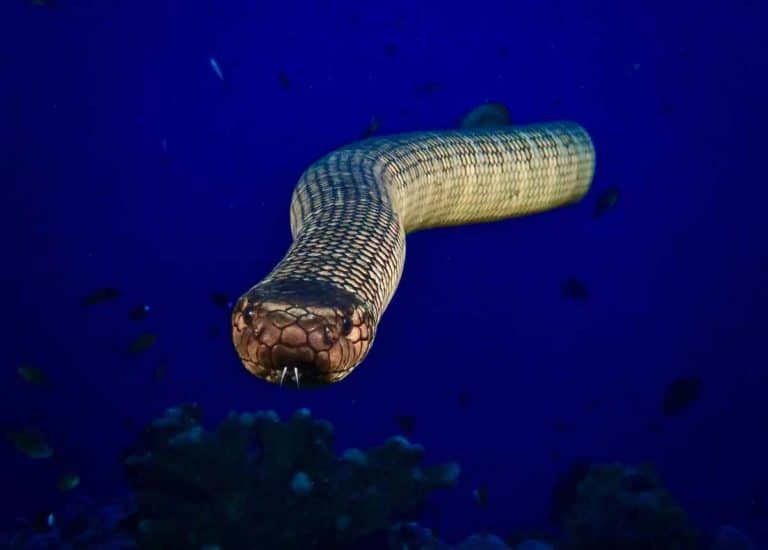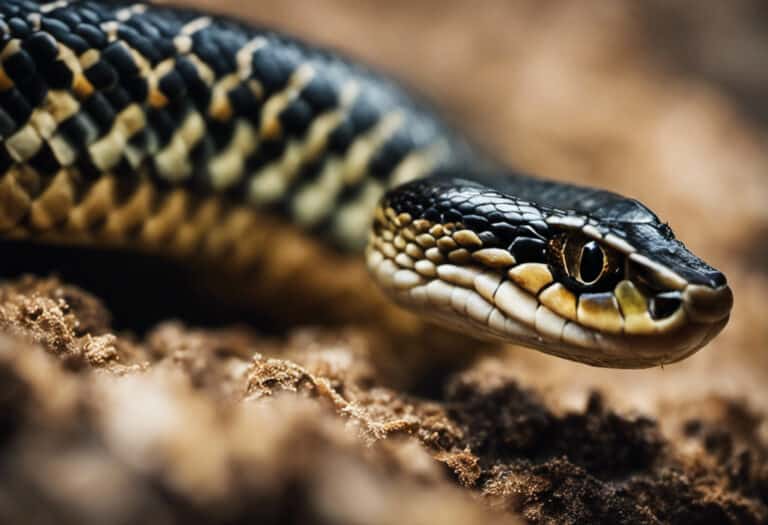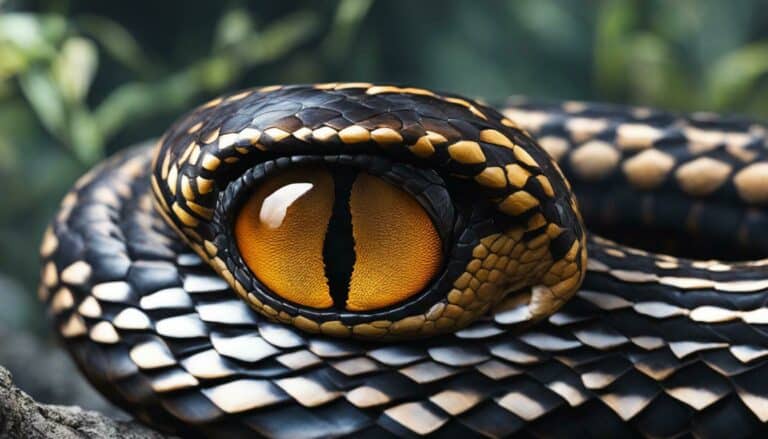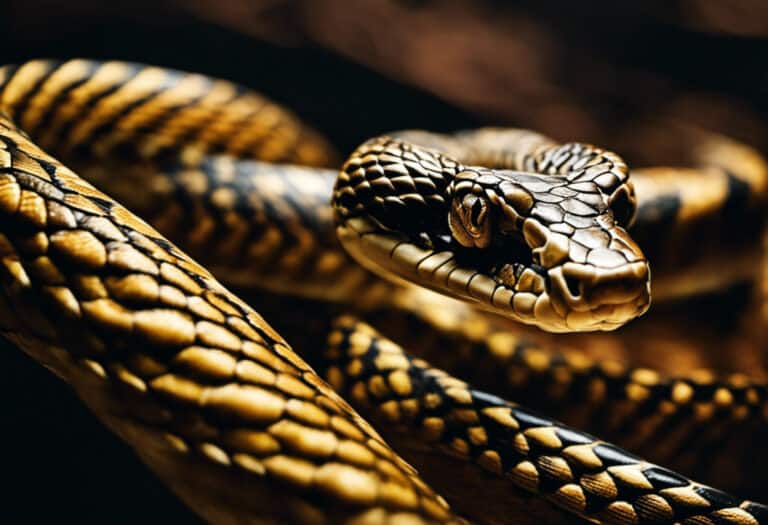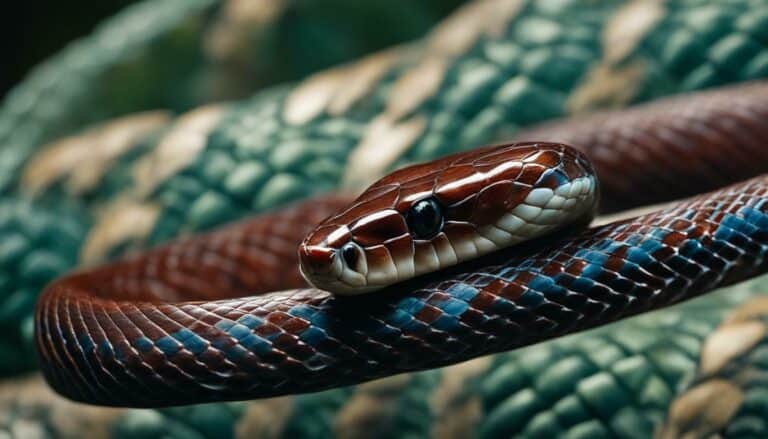What Do Mud Snakes Eat?
Do you ever wonder what mud snakes eat?
Dive into the fascinating world of these large, highly-aquatic snakes as we explore their diet.
With a glossy black back and a distinctive red-and-black checkerboard pattern on their belly, mud snakes can be found in the Coastal Plain of the southern United States.
They spend most of their lives hidden amongst vegetation and debris, but occasionally venture out to cross roads near aquatic habitats.
Stay tuned as we delve deeper into the intriguing world of mud snake diets.
Key Takeaways
- Mud snakes primarily feed on giant aquatic salamanders.
- Young snakes may consume other amphibians as their diet.
- Mud snakes are highly aquatic and spend most of their lives hidden amongst vegetation and debris.
- They are rarely seen and often encountered crossing roads adjacent to aquatic habitats.
Diet of Mud Snakes in the Wild
Mud snakes primarily feed on giant aquatic salamanders, but they may consume other amphibians when they’re young. Prey selection is crucial for the survival and ecological impact of mud snakes.
These snakes play a vital role in maintaining the balance of aquatic ecosystems. By targeting giant aquatic salamanders, mud snakes help control their population and prevent overpopulation. This, in turn, promotes the overall health and diversity of the ecosystem.
Additionally, mud snakes’ consumption of other amphibians during their early stages ensures that their diet remains varied and adaptable. This flexibility allows them to respond to changes in prey availability and environmental conditions.
Overall, mud snakes’ prey selection has significant ecological implications and contributes to the preservation of balanced and thriving aquatic environments.
Prey Preferences of Mud Snakes
Mud snakes have distinct prey preferences, primarily feeding on giant aquatic salamanders. Their diet consists mainly of these amphibians, which may have important implications for salamander populations in their habitat.
Studying the prey preferences of mud snakes provides valuable insights into the ecological dynamics of these secretive snakes and their impact on the amphibian community.
Preferred Amphibian Prey
Giant aquatic salamanders are the preferred amphibian prey of mud snakes. These snakes exhibit a diverse diet and have interesting foraging behavior. Here are some key points to consider:
- Mud snakes primarily feed on giant aquatic salamanders, showcasing their specialized preference for this particular prey.
- This diet diversity indicates their adaptability to a variety of aquatic habitats where these salamanders are found.
- Mud snakes employ unique foraging behavior to capture their prey, utilizing their highly-aquatic nature and ability to maneuver through vegetation and debris.
Understanding the preferred amphibian prey of mud snakes sheds light on their ecological role and feeding strategies. By targeting giant aquatic salamanders, these snakes demonstrate their ability to thrive in diverse environments and adapt to different foraging opportunities.
This knowledge enhances our understanding of the intricate relationships within aquatic ecosystems and provides valuable insights for their conservation.
Impact on Salamander Populations
You may be curious to know how the predation of mud snakes affects the populations of salamanders. Mud snakes play a significant role in shaping salamander populations through their feeding habits.
They primarily prey on giant aquatic salamanders, such as the amphiuma and sirens. This selective predation can have a direct impact on salamander populations, especially in areas where mud snakes are abundant.
However, it’s important to note that there are various factors influencing mud snakes’ food choices. These factors include the availability and abundance of their preferred prey, as well as the habitat conditions that support the presence of salamanders.
Therefore, changes in the populations of mud snakes can indirectly affect the populations of salamanders, highlighting the intricate ecological relationships between these species.
Further research is needed to fully understand the dynamics of this predator-prey interaction and its implications for salamander conservation efforts.
Key Food Sources for Mud Snakes
Mud snakes rely on a diverse range of amphibian prey as their key food sources. This includes giant aquatic salamanders, such as sirens and amphiumas, which make up the majority of their diet. Feeding on these amphibians is crucial for mud snakes to maintain their population and to contribute to the balance of the ecosystem.
Factors such as habitat loss and degradation can negatively impact the availability of these food sources, which may have further implications for the survival of mud snakes.
Amphibian Prey Preferences
The mud snake primarily feeds on aquatic salamanders, but it may consume other amphibians as well. This diet has significant implications for both the amphibian population decline and the impact on wetland ecosystems.
- Amphibian population decline:
- Mud snakes play a crucial role in regulating amphibian populations in wetland ecosystems.
- Their preference for salamanders helps to control their numbers, preventing overpopulation.
- The decline in mud snake populations could result in an increase in amphibian populations, leading to imbalances in the ecosystem.
- Impact on wetland ecosystems:
- As top predators in wetland habitats, mud snakes help maintain the balance of the ecosystem.
- By preying on salamanders and other amphibians, they help control their populations and prevent overgrazing on vegetation.
- The absence of mud snakes could lead to an increase in amphibian populations, which could have cascading effects on other species and disrupt the delicate balance of the wetland ecosystem.
Understanding the feeding habits of mud snakes is essential for preserving their populations and maintaining the health of wetland ecosystems.
Impact on Ecosystem Balance
Mud snakes play an important role in maintaining ecosystem balance, particularly in wetland habitats. These snakes have a significant impact on wetland health and contribute to the control of amphibian populations.
By feeding primarily on giant aquatic salamanders and occasionally consuming other amphibians, mud snakes help regulate the population sizes of these organisms.
This predation helps prevent potential overpopulation of amphibians, which could disrupt the delicate balance within wetland ecosystems.
Additionally, mud snakes indirectly contribute to wetland health by controlling the populations of their prey, which can have cascading effects on the entire ecosystem.
Through their feeding habits, mud snakes contribute to the overall balance and stability of wetland ecosystems.
To visualize their role in controlling amphibian populations, here is a table showcasing the amphibians commonly consumed by mud snakes:
| Mud Snake Diet | |
|---|---|
| Giant Aquatic Salamanders | Occasionally other amphibians |
Understanding the impact of mud snakes on wetland ecosystems and their role in controlling amphibian populations is crucial for maintaining the delicate balance of these habitats. By preserving and protecting the habitats of mud snakes, we can ensure the continued health and stability of wetland ecosystems.
Factors Affecting Food Availability
You might be interested to know that food availability for mud snakes is influenced by various factors, such as seasonal changes and the abundance of prey species. These factors play a crucial role in shaping the diet and foraging behavior of mud snakes, ultimately impacting the balance of aquatic ecosystems.
Factors influencing prey selection:
- Seasonal changes: Mud snakes adjust their diet based on the availability of prey throughout the year. For example, during the breeding season, they may target small fish and amphibians that are abundant in the water.
- Abundance of prey species: Mud snakes rely on a diverse range of prey, including giant aquatic salamanders and other amphibians. The abundance of these prey species within their habitat directly affects their food availability.
Impact on aquatic ecosystems:
- By feeding on various prey species, mud snakes help regulate their populations, preventing overpopulation in certain species.
- Mud snakes also serve as indicators of environmental health. Their presence or absence can provide valuable information about the overall condition of aquatic ecosystems.
- As predators, mud snakes contribute to the balance of the food web in aquatic ecosystems, playing a vital role in maintaining species diversity and overall ecosystem stability.
Understanding the factors influencing prey selection and the impact of mud snakes on aquatic ecosystems is crucial for conservation efforts and the preservation of these delicate habitats.
What Do Mud Snakes Hunt
Mud snakes primarily feed on giant aquatic salamanders, with young snakes occasionally consuming other amphibians. Their prey selection and feeding behavior are influenced by their habitat and the availability of suitable prey.
Mud snakes are highly specialized hunters, relying on their excellent swimming abilities and stealthy nature to capture their prey. They use their keen sense of smell and specialized receptors located on their tongues to detect the scent of their prey in the water.
Once they locate their prey, mud snakes strike with lightning speed, seizing and swallowing their prey whole. The ability to consume such large prey is facilitated by their flexible jaws, which allow them to stretch their mouths wide open.
Mud snakes are efficient predators, playing a vital role in the balance of aquatic ecosystems.
Amphibians in the Diet of Mud Snakes
Amphibians play a significant role in the diet of mud snakes, contributing to their overall feeding ecology. Mud snakes primarily feed on giant aquatic salamanders, such as the amphiuma and sirens, which are commonly found in wetland ecosystems.
These salamanders provide a rich source of nutrients for the snakes, helping them to maintain energy levels and support their growth and reproduction.
The inclusion of amphibians in the diet of mud snakes highlights the importance of conserving these species and their habitats. Wetlands serve as critical ecosystems for both amphibians and mud snakes, providing them with suitable environments and ample food resources. Protecting and preserving wetlands is essential for maintaining the delicate balance of these ecosystems and ensuring the survival of these species.
Feeding Habits of Mud Snakes
When hunting for food, mud snakes primarily target giant aquatic salamanders, such as the amphiuma and sirens, which provide them with essential nutrients for survival.
Mud snakes exhibit a selective prey selection and feeding behavior, focusing on these specific amphibians due to their abundance and nutritional value. They possess specialized adaptations that enable them to capture and consume their prey efficiently.
Mud snakes use their strong muscular bodies and sharp teeth to seize and restrain their targets. They employ constriction as their main method of subduing their prey, coiling their bodies around the salamanders and exerting pressure until they’re immobilized.
Once immobilized, mud snakes consume their prey whole, swallowing them headfirst. Their feeding behavior is highly efficient, allowing them to obtain the necessary nutrients for their survival in their aquatic habitats.
How Mud Snakes Catch and Consume Prey
You may be interested to know that mud snakes catch and consume their prey by using their strong muscular bodies and sharp teeth to seize and restrain them, and then employing constriction to immobilize them before swallowing them whole.
This hunting technique allows mud snakes to capture and consume a variety of prey, including amphibians, reptiles, and small mammals. Mud snakes are skilled hunters, using their powerful bodies to quickly overpower their prey and their sharp teeth to secure a firm grip.
Once the prey is restrained, the mud snake wraps its body around it, applying pressure to prevent escape. This constriction technique effectively immobilizes the prey, making it easier for the mud snake to swallow it whole.
Mud snakes are highly adaptable and capable hunters, utilizing these techniques to ensure a successful meal.
Variations in Mud Snakes’ Diet
Now let’s explore the variations in mud snakes’ diet.
Mud snakes exhibit diverse prey selection and foraging behavior. While their primary diet consists of giant aquatic salamanders, they’ve been observed consuming other amphibians as well. This suggests that mud snakes may be opportunistic feeders, adapting their diet based on the availability of prey in their habitat.
Their ability to consume a variety of amphibians may be advantageous in environments where salamanders are scarce. Mud snakes use their strong jaws and specialized teeth to capture and consume their prey. They employ an ambush hunting strategy, lying in wait for unsuspecting prey to approach before striking with lightning speed.
This foraging behavior allows mud snakes to efficiently catch and consume their desired prey, ensuring their survival in their aquatic habitats.
Factors Influencing Mud Snakes’ Food Choices
One factor that influences the food choices of mud snakes is the availability of prey in their habitat. Mud snakes have a varied diet, consisting primarily of giant aquatic salamanders. However, young snakes may consume other amphibians as well.
Their foraging behavior is influenced by the abundance and accessibility of prey species in their environment. Mud snakes are highly aquatic and spend most of their time hidden amongst vegetation and debris, making it easier for them to ambush their prey. They’ve specialized adaptations, such as their glossy black back and red-and-black checkerboard pattern on their belly, that aid in their camouflage and stealthy hunting.
Their small, dark eyes allow them to detect movement in their surroundings, enabling them to locate potential prey. Overall, the prey selection and foraging behavior of mud snakes are shaped by the availability and characteristics of their preferred food sources in their aquatic habitats.
Frequently Asked Questions
How Do Mud Snakes Catch and Consume Their Prey?
Mud snakes catch and consume their prey using various hunting techniques. They are highly-aquatic and primarily feed on giant aquatic salamanders. Young snakes may consume other amphibians.
Are There Any Variations in the Diet of Mud Snakes?
Mud snakes have dietary preferences influenced by factors such as prey availability and habitat. While they primarily feed on giant aquatic salamanders, variations in their diet may occur depending on the availability of other amphibians.
What Factors Influence Mud Snakes’ Food Choices?
Factors influencing mud snakes’ food choices include availability, prey abundance, and habitat characteristics. Seasonal variations in diet may occur as prey availability changes. Further research is needed to fully understand the specific factors influencing their food choices.
Do Mud Snakes Primarily Feed on Amphibians?
Mud snakes primarily feed on giant aquatic salamanders, but young snakes may consume other amphibians. Their diet consists mainly of these aquatic prey, reflecting their highly aquatic nature and their preference for wetland habitats.
What Are the Key Food Sources for Mud Snakes in the Wild?
Mud snakes primarily feed on giant aquatic salamanders, but they may consume other amphibians as well. Factors affecting their food choices include availability of prey and habitat conditions. It is unclear if mud snakes eat fish.
Conclusion
In conclusion, the diet of mud snakes primarily consists of giant aquatic salamanders, with young snakes occasionally consuming other amphibians. These snakes exhibit non-aggressive behavior towards humans and pose no threat.
When captured, they may press their tail tip harmlessly. Female mud snakes lay their eggs in sandy upland habitats near water, with the average clutch size being around 20-30 eggs.
The fascinating world of mud snake diets showcases their unique feeding habits and preferences in the wild.
